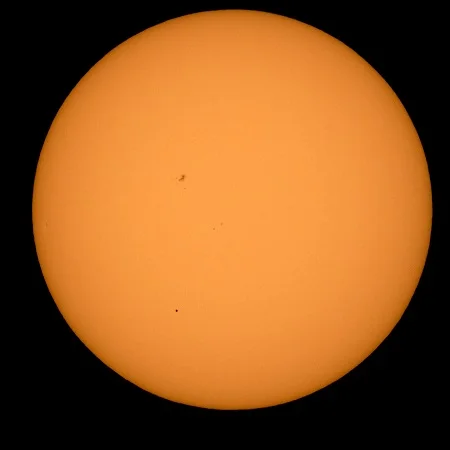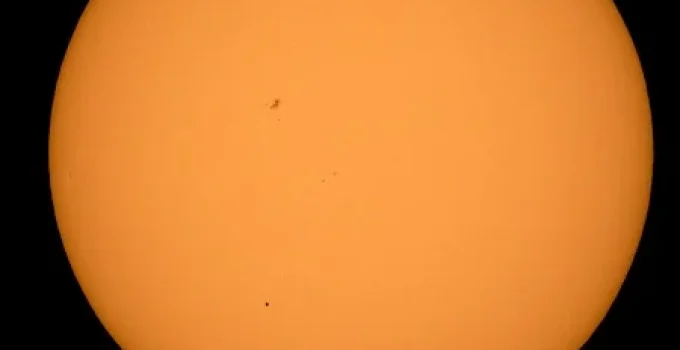Dive Deeper
- 🔭 Can You See Mercury from Earth?
- 🌅 When Is Mercury Visible?
- 🪐 Why Is Mercury Hard to See?
- 📌 Tips for Seeing Mercury
- 📸 What Does Mercury Look Like?
- 🎯 Final Thoughts
- 📚 References
🔭 Can You See Mercury from Earth?

Photo Credit: (NASA/Bill Ingalls)
Yes, you can see Mercury from Earth—but it’s not easy! Mercury is one of the five planets visible without a telescope, along with Venus, Mars, Jupiter, and Saturn. Even though it’s the closest planet to the Sun, Mercury is often hidden by the Sun’s glare, which makes it hard to spot.
Because of its small size and fast orbit, Mercury is only visible during certain times of the year—and only for a short time during sunrise or sunset. That’s why people sometimes call it “the elusive planet.”
🌅 When Is Mercury Visible?
Mercury is visible during special events called elongations—these are times when it appears farthest from the Sun in the sky. During an elongation, you can see Mercury just after sunset (evening sky) or just before sunrise (morning sky).
| Type of Elongation | Best Time to Look | Sky Direction | Description |
|---|---|---|---|
| Greatest Eastern | After sunset | Western sky | Evening view |
| Greatest Western | Before sunrise | Eastern sky | Morning view |
📊 Fact: Mercury becomes visible to the naked eye about 6 to 10 times per year, depending on your location [1].
The best viewing conditions usually happen around 30–60 minutes after sunset or before sunrise. If you wait too long, Mercury will either sink below the horizon or get lost in the Sun’s brightness.
🪐 Why Is Mercury Hard to See?
There are a few reasons Mercury is one of the hardest planets to spot:
- Too close to the Sun – Mercury never strays far from the Sun, so it’s always low in the sky.
- Short viewing window – It only appears for a little while during twilight.
- Faint brightness – It’s not as bright as Venus, so it doesn’t stand out as easily.
- Light pollution – City lights can make it even harder to see Mercury near the horizon.
Also, Mercury never appears high in the sky like other planets. At its best, it might only rise 10 to 20 degrees above the horizon, which is low compared to the Moon or Jupiter.
📌 Tips for Seeing Mercury
Want to try spotting Mercury? Here are some tips to improve your chances:
- Find a clear horizon – Look for a place with an open view of the eastern or western horizon (no trees or buildings).
- Use a stargazing app – Apps like SkyView or Stellarium can help you know exactly where to look.
- Check a sky calendar – Look up Mercury’s next elongation dates online.
- Go out during twilight – Don’t wait until it’s fully dark. Mercury disappears quickly!
- Use binoculars – These can help you see Mercury’s tiny disc or confirm it’s not a star.
- Watch with others – Stargazing is always more fun (and safer) with a friend or group.
🌤️ Weather Tip: Choose a night with clear skies and no haze or fog. Even thin clouds can block your view of this small planet.
📸 What Does Mercury Look Like?
To the naked eye, Mercury looks like a small, bright star near the horizon. It doesn’t twinkle much, and it may appear yellowish or white.
Through a telescope, you can see Mercury’s phases, just like the Moon. Depending on its position, it might look like a half-circle, crescent, or full disc.
| View Type | What You’ll See |
|---|---|
| Naked eye | Bright, star-like object |
| Binoculars | Slightly larger point |
| Small telescope | Crescent or half-phase |
Because it’s so close to the Sun, you should NEVER try to view Mercury during the day, especially with binoculars or telescopes, unless you’re a trained astronomer. It’s dangerous and could damage your eyes.
🎯 Final Thoughts
Yes, you can see Mercury from Earth, but it takes good timing, a clear view, and a bit of patience. While it’s the hardest of the visible planets to spot, catching a glimpse of Mercury is an exciting challenge for skywatchers of all ages. With the right tools and a little planning, you might just be lucky enough to see the fastest planet zipping across the sky.
So next time you hear about a Mercury elongation, step outside during twilight—and try to spot this speedy, shy neighbor of ours!
📚 References
- NASA Night Sky Network – Observing Mercury: https://nightsky.jpl.nasa.gov
- EarthSky – Mercury Elongation Dates: https://earthsky.org/tonight/
- U.S. Naval Observatory – Mercury Visibility: https://aa.usno.navy.mil
- Sky & Telescope – Tips for Viewing Mercury: https://skyandtelescope.org/observing/mercury
- Britannica – Mercury (Planet): https://www.britannica.com/place/Mercury-planet
